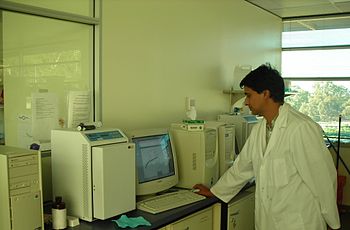Modern plant breeding

Modern plant breeding may use techniques of molecular biology to select, or in the case of genetic modification, to insert, desirable traits into plants. Application of biotechnology or molecular biology is also known as molecular breeding.
This section does not cite any sources. (March 2017) (Learn how and when to remove this template message) |
Marker assisted selectionedit
Sometimes many different genes can influence a desirable trait in plant breeding. The use of tools such as molecular markers or DNA fingerprinting can map thousands of genes. This allows plant breeders to screen large populations of plants for those that possess the trait of interest. The screening is based on the presence or absence of a certain gene as determined by laboratory procedures, rather than on the visual identification of the expressed trait in the plant. The purpose of marker assisted selection, or plant genome analysis, is to identify the location and function (phenotype) of various genes within the genome. If all of the genes are identified it leads to genome sequence.citation neededclarification needed All plants have varying sizes and lengths of genomes with genes that code for different proteins, but many are also the same. If a gene's location and function is identified in one plant species, a very similar gene likely can also be found in a similar location in another related species genome.
Reverse breeding and doubled haploids (DH)edit
clarification neededHomozygous plants with desirable traits can be produced from heterozygous starting plants, if a haploid cell with the alleles for those traits can be produced, and then used to make a doubled haploid. The doubled haploid will be homozygous for the desired traits. Furthermore, two different homozygous plants created in that way can be used to produce a generation of F1 hybrid plants which have the advantages of heterozygosity and a greater range of possible traits. Thus, an individual heterozygous plant chosen for its desirable characteristics can be converted into a heterozygous variety (F1 hybrid) without the necessity of vegetative reproduction but as the result of the cross of two homozygous/doubled haploid lines derived from the originally selected plant. Plant tissue culturing can produce haploid or double haploid plant lines and generations. This cuts down the genetic diversity taken from that plant species in order to select for desirable traits that will increase the fitness of the individuals. Using this method decreases the need for breeding multiple generations of plants to get a generation that is homogenous for the desired traits, thereby saving much time over the natural version of the same process. There are many plant tissue culturing techniques that can be used to achieve haploid plants, but microspore culturing is currently the most promising for producing the largest numbers of them.
Genetic modificationedit
Genetic modification of plants is achieved by adding a specific gene or genes to a plant, or by knocking down a gene with RNAi, to produce a desirable phenotype. The plants resulting from adding a gene are often referred to as transgenic plants. If for genetic modification genes of the species or of a crossable plant are used under control of their native promoter, then they are called cisgenic plants. Sometimes genetic modification can produce a plant with the desired trait or traits faster than classical breeding because the majority of the plant's genome is not altered.
To genetically modify a plant, a genetic construct must be designed so that the gene to be added or removed will be expressed by the plant. To do this, a promoter to drive transcription and a termination sequence to stop transcription of the new gene, and the gene or genes of interest must be introduced to the plant. A marker for the selection of transformed plants is also included. In the laboratory, antibiotic resistance is a commonly used marker: Plants that have been successfully transformed will grow on media containing antibiotics; plants that have not been transformed will die. In some instances markers for selection are removed by backcrossing with the parent plant prior to commercial release.
The construct can be inserted in the plant genome by genetic recombination using the bacteria Agrobacterium tumefaciens or A. rhizogenes, or by direct methods like the gene gun or microinjection. Using plant viruses to insert genetic constructs into plants is also a possibility, but the technique is limited by the host range of the virus. For example, Cauliflower mosaic virus (CaMV) only infects cauliflower and related species. Another limitation of viral vectors is that the virus is not usually passed on to the progeny, so every plant has to be inoculated.
The majority of commercially released transgenic plants are currently limited to plants that have introduced resistance to insect pests and herbicides. Insect resistance is achieved through incorporation of a gene from Bacillus thuringiensis (Bt) that encodes a protein that is toxic to some insects. For example, the cotton bollworm, a common cotton pest, feeds on Bt cotton it will ingest the toxin and die. Herbicides usually work by binding to certain plant enzymes and inhibiting their action. The enzymes that the herbicide inhibits are known as the herbicides target site. Herbicide resistance can be engineered into crops by expressing a version of target site protein that is not inhibited by the herbicide. This is the method used to produce glyphosate resistant ("Roundup Ready") crop plants.
Genetic modification can further increase yields by increasing stress tolerance to a given environment. Stresses such as temperature variation, are signalled to the plant via a cascade of signalling molecules which will activate a transcription factor to regulate gene expression. Overexpression of particular genes involved in cold acclimation has been shown to produce more resistance to freezing, which is one common cause of yield loss
Genetic modification of plants that can produce pharmaceuticals (and industrial chemicals), sometimes called pharming, is a rather radical new area of plant breeding.
Comments
Post a Comment